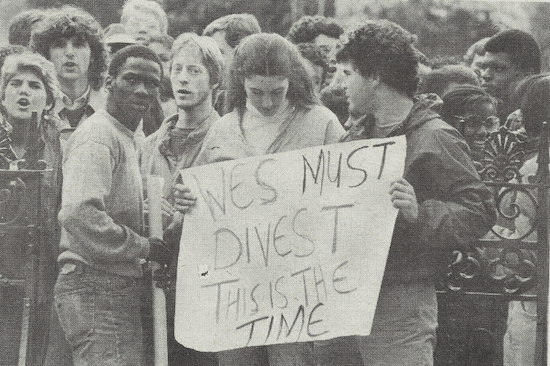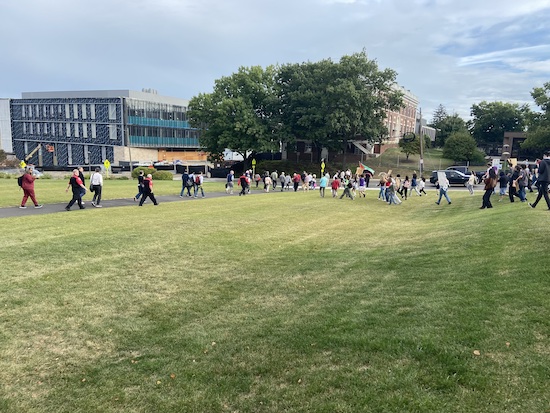
Student protestors outside Russell House on April 13, 1985. Originally published in The Argus on April 13, 1985. c/o Shane Sureck ’83
Like many other colleges and universities, Wesleyan is no stranger to student protests. Recent divestment rallies and demonstrations for Palestine have taken place on campus this year. Political engagement and protests have always been prominent forces at the University, and the activity surrounding student activism this year is just as strong as it was almost 40 years ago.
After seeing the recent divestment rally and the board of trustees vote against a divestment proposal from the Committee for Investment Responsibility (CIR) in September, we thought we’d zoom backward to 1985, another monumental year on campus for divestment rallies and reform.
In 1985, South Africa was in the midst of intense turmoil and social unrest, primarily because its apartheid regime enforced a system of racial segregation and discrimination against non-white South Africans who made up a majority of the population. In 1985, there were many anti-apartheid protests and divestment rallies at universities nationwide, and our campus was one of them.
On April 13, 1985, 450 University students rallied for divestment from companies doing business in South Africa. An April 16, 1985, article titled “S. Africa protests is largest since Vietnam War,” by then-writer Aaron Schloff ’88, details the rally’s events.
“Over four hundred students lined the sidewalk of High Street Saturday afternoon,” Schloff wrote. “…. The students stood silently along with some faculty members and Middletown residents as trustees walked from Downey House…to Russell House, where in turn the Board met and approved changes in the University’s policy on its investments in South Africa.”
The rally was organized by a student organization named the South African Action Group.
“According to Professor of Romance Languages Carl Viggiani…it was the largest student rally on the Wesleyan campus since the peace protests of the late 1960s,” Schloff wrote.
According to the article, the rally began at 12:30 p.m. with students gathering in front of the Campus Center to hear rally organizers Issac Shongwe ’87 and Hobie Crystle ’85 speak. Protesters then quietly walked to High Street, where they lined both sides of the sidewalk between Court and High Street and Russell House and waited for the trustees.
“The 19 black students lay on the lawn outside the Russell House fence,” Schloff wrote.
While lining the sidewalk, protesters continued talking while sitting and waiting for the trustees.

Protestors confronting administration during the Sept. 21, 2024 divestment rally. c/o Arya Dansinghani
“When the trustees began coming out of Downey, the protestors stood up and stopped talking,” Schloff wrote. “Some held banners with slogans like ‘WE DON’T WANT BLOOD MONEY,’…as trustees and university officials walked by.”
Protestors explained that the silent protest was a visual statement. They wanted the trustees to have to look at them, and, according to Schloff, while some of the trustees looked away, they all briefly looked at the protestors.
“Once almost all the trustees were in Russell House, a group of student trustees marched down the walk chanting ‘divest now!’” Schloff wrote.
This was followed by more chanting until the protesters dispersed at around 2:30 p.m. The rally was well publicized with various news channels, radio stations, the Middletown Press, and the Boston Globe all covering the events.
Although the board didn’t vote to divest, the vote and response from the University weren’t all negative, similar to the divestment vote this September.
Schloff also detailed organizers’ and student protesters’ responses to the vote. According to Schloff, organizers of the rally, while pleased with the protests and the actions of the board, felt that they fell far short of the goal of full divestment.
“[The board’s decision may] improve conditions for some of the people—making the chains comfortable,” Isaac Shongwe ’78, an organizer of the rally, was quoted as saying in the article. “The only way we can remove these chains is by divesting.”
Another article—published on the same day by Schloff and entitled “Trustees adopt new guidelines for investments”—detailed the board’s vote.
“Wesleyan will require more social action from its investments which do business in South Africa, the Board of Trustees voted Saturday,” Schloff wrote. “The Board did not vote to divest anywhere; rather, companies will now be asked to comply with a newly expanded version of the Sullivan Principles.”
In a letter to the editors, published the same day, titled “Looking for a policy both moral and effective,” then-University President Colin Campbell expanded on the board’s decision and expressed how the protest moved him.
“I was deeply moved by Saturday’s anti-apartheid protests,” Campbell wrote. “…. I was impressed also by the Board of Trustees’ heightened concern about development in South Africa….. Wesleyan is asking companies doing business in South Africa, whose shares the University owns, to accelerate activities intended [to] bring about structural change in that country by peaceful means.”
Campbell went on to explain the questions that the board would be asking the companies doing business in South Africa to evaluate how they were using their influence to support the elimination of apartheid laws.
“[T]he board has taken three steps: it has authorized additional administrative support in the Treasurer’s office; it has provided funding for supplemental research on corporate conduct and attitudes; and it has urged increased information sharing among the 18 colleges and universities that are members of the research consortium on South Africa established last year under Wesleyan’s leadership,” Campbell wrote.
While the September divestment vote and response to the rally fell short of the pro-Palestine student group Beyond Empire’s goals, the 1985 anti-apartheid divestment rally reminds us that student protest can and does result in change.
Arya Dansinghani can be reached at adansinghani@wesleyan.edu.
“From the Argives” is a column that explores The Argus’ archives (Argives) and any interesting, topical, poignant, or comical stories that have been published in the past. Given The Argus’ long history on campus and the ever-shifting viewpoints of its student body, the material, subject matter, and perspectives expressed in the archived article may be insensitive or outdated, and do not reflect the views of any current member of The Argus. If you have any questions about the original article or its publication, please contact Head Archivists Sida Chu at schu@wesleyan.edu and Maggie Smith at mssmith@wesleyan.edu.